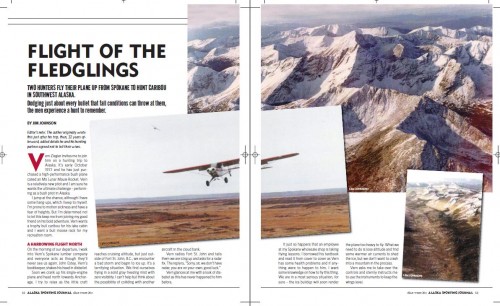
NFWF, Partners To Provide Grant Money For Alaskan Fish And Wildlife Projects
The following is courtesy of the National Fish and Wildlife Foundation:
ANCHORAGE, Alaska (March 29, 2022) – The National Fish and Wildlife Foundation (NFWF) today announced more than $672,000 in grants to improve measurable on-the-ground conservation outcomes for fish and wildlife populations, fill key information gaps, support Pacific salmon priorities throughout the State, and increase Alaska Native community stewardship and engagement in the Alaska North Slope, Cook Inlet, Kodiak Archipelago, the Chugach and Tongass National Forests.
The grants will leverage $1,192,000 in matching contributions to generate a total conservation impact of $1,864,000. These grants were awarded through NFWF’s Alaska Fish and Wildlife Fund(AFWF), a partnership between NFWF, the USDA Forest Service and the U.S. Fish and Wildlife Service.
“The project funding announced today will produce measurable benefits for fish and wildlife,” said Jeff Trandahl, executive director and CEO of NFWF. “These grants incorporate outreach to Alaska Native communities, foster community engagement and support collaborative wildlife management strategies, because we know that Alaska Native community stewardship and engagement are essential to effective conservation efforts in the State.”
Projects included in this grant slate will seek to protect, enhance and restore essential Pacific salmon habitat to ensure the long-term viability of populations and fill data gaps that will directly inform subsistence managers. Projects will replace infrastructure to allow aquatic organism passage, restore instream and coastline habitat, and survey watershed temperature conditions to better understand salmon response.
“As someone who worked for years as a fish biologist, seeing these grant opportunities makes me optimistic for the future of Alaska’s fish and wildlife,” said Dave Schmid, regional forester for the Alaska Region of the USDA Forest Service. “Working to sustain our fish and wildlife populations will ensure we can share these resources and our way of life for generations to come.”
Grants will also fill information gaps on migratory movements of birds to determine areas where they may be vulnerable and support efforts to continue the monitoring and management of Steller’s and spectacled eiders on Alaska’s North Slope.
“The U.S. Fish and Wildlife Service is proud to work with the National Fish and Wildlife Foundation in setting priorities for the Alaska Fish and Wildlife Fund,” said Michael Daigneault, Regional Habitat Restoration and Partnerships Coordinator for the U.S. Fish and Wildlife Service. “This year’s suite of projects address some of Alaska’s highest priority conservation needs, such as engaging Tribal youth in conservation, restoring important salmon habitat, and understanding trends of threatened species. These projects will positively change the trajectory for Alaska’s fish and wildlife, leaving a lasting conservation legacy.”
Additionally, grants will engage communities in best practices to prevent the spread of invasive aquatic plants and provide opportunities for Alaska Native and Alaska youth to engage in conservation activities.
The AFWF was established in 2008 to further conservation of species and habitat, while supporting communities responding to challenges presented by changing climate and land use in Alaska. Since the fund’s inception, more than $12 million has been invested in 152 projects, leveraging more than $26.9 million in grantee matching contributions for a total on-the-ground conservation impact of more than $38.9 million.
A complete list of the 2022 grants made through the Alaska Fish and Wildlife Fund is available here.
About the National Fish and Wildlife Foundation
Chartered by Congress in 1984, the National Fish and Wildlife Foundation (NFWF) protects and restores the nation’s fish, wildlife, plants and habitats. Working with federal, corporate, foundation and individual partners, NFWF has funded more than 6,000 organizations and generated a total conservation impact of $7.4 billion. Learn more at www.nfwf.org.About the USDA Forest Service
The USDA Forest Service has brought people and communities together to answer the call of conservation for more than 100 years. Grounded in world-class science and rooted in communities, the Forest Service connects people with nature and to each other. The Forest Service cares for shared natural resources in ways that promote lasting economic, ecological, and social vitality. 193 million acres of national forests and grasslands contribute more than $13 billion to the economy each year through visitor spending alone. The Forest Service also maintains the largest forestry research organization in the world and assists state and private landowners, helping to steward about 900 million forested acres in the U.S., including 130 million acres in urban areas, which most Americans now call home.About the U.S. Fish and Wildlife Service
The mission of the U.S. Fish and Wildlife Service is working with others to conserve, protect, and enhance fish, wildlife, plants, and their habitats for the continuing benefit of the American people. We are both a leader and trusted partner in fish and wildlife conservation, known for our scientific excellence, stewardship of lands and natural resources, dedicated professionals, and commitment to public service. For more information on our work and the people who make it happen, visit www.fws.gov.
#



